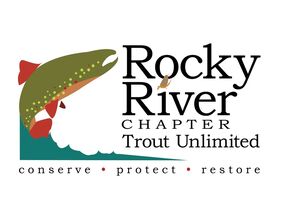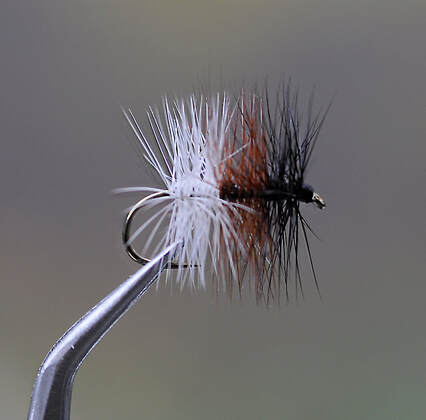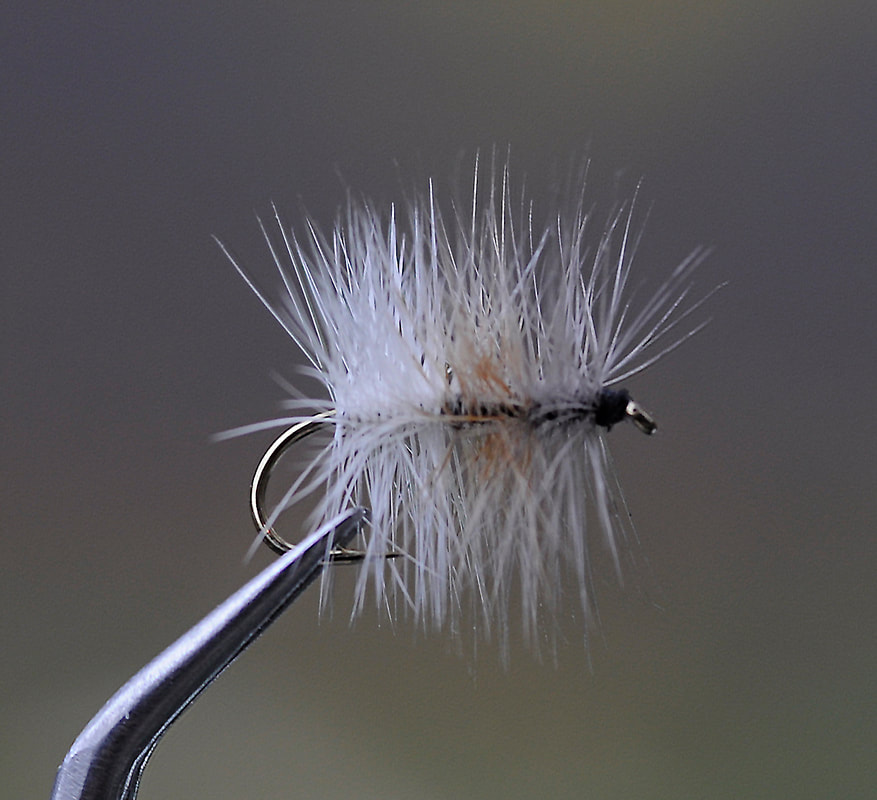Fly of the Month
Colors work to suggest a given match to a “bug” in the water on a stream or an attractive color that fish can not resist or a highly visible color that helps the angler see the fly pattern on the water while being presented.
What happened when a fly pattern is three different colors? It depends on the colors. Using one of the colors as an indicator or Hi-Vis component of the fly pattern still leaves two colors. For the Bivisible, white is used as the Hi-Vis component, then the second color is the color of the fly to be imitated. Having two colors in addition to the indicator allows for a more suggestive “bug” with maybe a dark and darker or a light and lighter color of the fly to be imitated. Or, the tow colors could also be bright and attractive.
Tricolores
The Tricolores is a French palmered fly pattern used to attract trout and grayllng. The original fly pattern suggests a “bug” with a dark and darker color of the fly being imitated. However, in modern times anglers use any and all colors for attractor fly patterns.
We present the original fly pattern and suggest the following color combinations and the logic behind the color combination:
White/Brown/Black (original)
White/Tan/Gray …a light version of the original
White/Olive/Lime …a green insect combination
Yellow/Orange/Red …a bright, fire tiger combination that attracts any fish
Yellow/Orange/Green …another fire tiger combination
Yes, you can tie a Tricolores Using Pink/Purple/Blue but who knows if it will attract or scare off a trout. There is but one way to find out!
Tricolores
Fly of the Month 12.18
Tom Adams and Alen Baker
Colors work to suggest a given match to a “bug” in the water on a stream or an attractive color that fish can not resist or a highly visible color that helps the angler see the fly pattern on the water while being presented.
What happened when a fly pattern is three different colors? It depends on the colors. Using one of the colors as an indicator or Hi-Vis component of the fly pattern still leaves two colors. For the Bivisible, white is used as the Hi-Vis component, then the second color is the color of the fly to be imitated. Having two colors in addition to the indicator allows for a more suggestive “bug” with maybe a dark and darker or a light and lighter color of the fly to be imitated. Or, the tow colors could also be bright and attractive.
Tricolores
The Tricolores is a French palmered fly pattern used to attract trout and grayllng. The original fly pattern suggests a “bug” with a dark and darker color of the fly being imitated. However, in modern times anglers use any and all colors for attractor fly patterns.
We present the original fly pattern and suggest the following color combinations and the logic behind the color combination:
White/Brown/Black (original)
White/Tan/Gray …a light version of the original
White/Olive/Lime …a green insect combination
Yellow/Orange/Red …a bright, fire tiger combination that attracts any fish
Yellow/Orange/Green …another fire tiger combination
Yes, you can tie a Tricolores Using Pink/Purple/Blue but who knows if it will attract or scare off a trout. There is but one way to find out!
Tricolores
Fly of the Month 12.18
Tom Adams and Alen Baker
Tricolores
Recipe :
Hook : Dry fly Tiemco 100 or equivalent, sizes 12,14,16,18,20
Thread : Black 8/0 or equivalent
Body : Black, Brown, White rooster hackle
Directions :
Recipe :
Hook : Dry fly Tiemco 100 or equivalent, sizes 12,14,16,18,20
Thread : Black 8/0 or equivalent
Body : Black, Brown, White rooster hackle
Directions :
- Debard and mount the hook in the vise. Tie in the thread and advance to the hook bend in tight touching turns and let the bobbin hang.
- Select a white dry rooster hackle by measuring with a hackle gauge or by holding at right angles to the stem and pulling slightly to expand the barbs. The barb should be about the same as the hook gape. Once you are satisfied repeat the process with the brown, and black feathers. Beginning with any of the feathers, strip about a quarter inch of barbs to expose a short tie stem. Tie in the white hackle with the curve of the barbs facing the eye (the dull side) allowing for one wrap of hackle without barbs at the end of the hook shank at the hook bend. Bring the thread to the halfway mark and let the bobbin hang. Make tight touching turns of the rooster to the one third mark from the bend. Make several thread wraps to secure the hackle while “wiggling” the thread through the barbs to avoid unnecessary trapping of barb. Once you have three or so turns, trim away the waste hackle and let the bobbin hang.
- Repeat the process with the brown and black feathers.
- Form a small thread head, whip finish and trim the waste thread.


